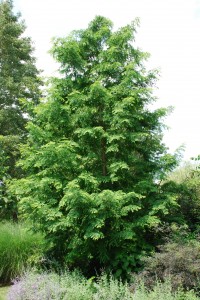Dawn redwood (Metasequoia glyptostroboides) was thought to be extinct until the mid-twentieth century. In 1948 dawn redwood was re-introduced into North America from Sichuan-Hubei Provinces in China.
Dawn redwood grows in full sun and in well-drained, compost-rich soil. The tree struggles in dry or high pH soils. Dawn redwood will tolerate standing water for a brief period. It is often confused with bald cypress (Taxodium distichum) which grows in swampy ground as well as average landscape soils. If branched low to the ground, the trunk of dawn redwood may develop large swollen areas called “boles”.
Dawn redwood is a deciduous conifer. New spring leaves emerge bright green and darken to a medium green. In autumn the fine textured foliage initially turns pinkish tan and finishes reddish bronze before dropping. An attractive shredded reddish brown bark clothes a tapered trunk. Dawn redwood possesses distinctive “arm pits” or depressed areas under each branch, where it is attached to the main trunk. The straight trunk and redwood bark are dominant winter features.
Dawn redwood foliage remains fresh and clean all summer and is not plagued by disease and pest problems. Spider mites and Japanese beetles may injure the foliage occasionally, but its quick growth rate leads to a swift recovery. Dawn redwoods often mature to 90-100 foot tall specimen trees, and are suited for large properties such as public parks, golf courses and college campuses.
Gold Rush® (‘Ogon’) metasequoia is a gold-leaved form. It has a slower growth rate and matures to 50-60 feet.


 Posted in
Posted in 
